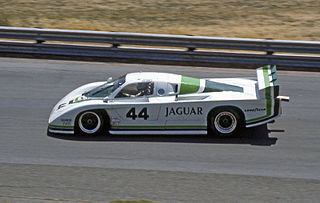
Bill Adam is a Canadian racing driver born in Airdrie, North Lanarkshire, Scotland.

The Porsche 962 is a sports-prototype racing car built by Porsche as a replacement for the 956 and designed mainly to comply with IMSA's GTP regulations, although it would later compete in the European Group C formula as the 956 had. The 962 was introduced at the end of 1984, from which it quickly became successful through private owners while having a remarkably long-lived career, with some examples still proving competitive into the mid-1990s. The vehicle was later replaced by the Porsche WSC-95.

The Jaguar XJR-9 is a sports-prototype race car built by Jaguar for both FIA Group C and IMSA Camel GTP racing, debuting at the 1988 24 Hours of Daytona.

Alvah Robert "Al" Holbert was an American automobile racing driver who was a five-time champion of the IMSA Camel GT series. He once held the record with the most IMSA race wins at 49.
John Lee Paul Jr. was an American racing driver. He competed in CART and the Indy Racing League competitions, but primarily in IMSA GT Championship, winning the title in 1982.

Steve Millen is a retired New Zealand IMSA race car driver. In the 1970s and 1980s, Millen raced in hillclimbing and Formula Ford before doing stadium off-road racing in the United States in the Mickey Thompson Entertainment Group (MTEG). He then began sports car racing, winning numerous championships in IMSA Camel GT. Millen won 20 races in the series, including the 24 Hours of Daytona and the 12 Hours of Sebring.
Dyson Racing is a professional sports car racing team based in Poughkeepsie, New York in the United States. Founded by Rob Dyson in 1974, the team competed successfully in North American sports car racing series, including the IMSA GT Championship and American Le Mans Series.

Spice Engineering was a British racing team founded by driver Gordon Spice with Raymond Bellm in the early 1980s, later becoming a successful sports car constructor in 1986. They competed in the World Sportscar Championship in Europe as well as the IMSA GT Championship in North America, at times partnering with major manufacturers such as General Motors and Honda as well as race engine manufacturer Comptech.

IMSA GT was a sports car racing series organized by International Motor Sports Association. Races took place primarily in the United States, and occasionally in Canada.
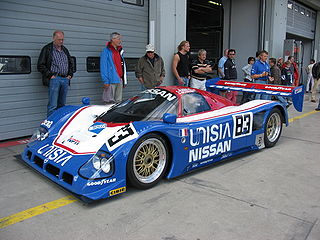
The Nissan R90C was a platform used for Group C racing cars built in 1990 by Nissan Motors for competition in World Sportscar Championship (WSC) based in Europe and the All Japan Sports Prototype Championship (JSPC). The cars based on the basic R90C platform would compete until 1993 before Nissan chose to withdraw from sports car racing, not returning until 1997. It won three JSPC championships and several significant endurance races during its career.
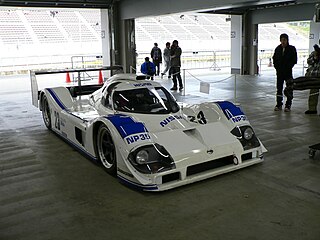
The Nissan P35 was a planned Group C car built by Nissan Motors for competition in the World Sportscar Championship. Developed by Nissan Performance Technology Inc. (NPTI), which had formerly raced under the name Electramotive in the United States, the cars were intended to be completed by the middle of 1992, with competition starting in 1993. However economic troubles for Nissan led to the cancellation of the project soon after testing of the first cars had begun, meaning that the P35s never raced.
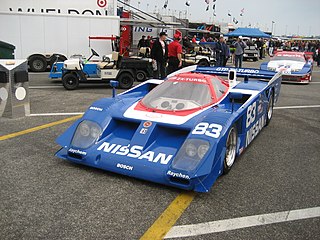
The Nissan GTP ZX-Turbo was a series of racing cars developed for Nissan Motors by Electramotive Engineering to compete in the IMSA GT Championship. Running from 1985 to 1990, they were known for being the first car to defeat the Porsche 962 which had dominated IMSA's premiere GTP category. This led to Nissan winning the constructor's championship and 12 Hours of Sebring in 1989 and 1990. During 1990, the GTP ZX-Turbo was replaced by the newer NPT-90.

The Mazda RX-792P is a sports prototype racing car built for the IMSA GT Championship's GTP category for Mazda. Its career was short lived, with only two cars running in 1992 before the project was abandoned.
The 1990 Camel GT Championship season was the 20th season of the IMSA GT Championship auto racing series. It consisted of GTP and Lights classes of prototypes, as well as Grand Tourer-style racing cars which ran in the GTO and GTU classes, as well as a tube-frame All-American Challenge (AAC) class during select GT-only rounds. It began February 3, 1990, and ended November 11, 1990, after twenty rounds.
Jeremy Dale is a Canadian racing driver. His career in motorsports has spanned more than 30 years as a racer, television commentator, race series director, race team president, and race team owner.

The Eagle MkIII is a sports prototype racing car built by All American Racers in 1991 to IMSA GTP specifications. Powered by a turbocharged Toyota inline-4 engine, the car was campaigned in the IMSA Camel GT series by Dan Gurney's Toyota-sponsored AAR team from 1991 through to the end of 1993. The Eagle MkIII won 21 out of the 27 races in which it was entered and is considered one of the most successful and technologically advanced designs of the IMSA GTP era — "a car that proved so overwhelmingly dominant that the class for which it was created has now been assigned to history", according to Racer magazine.

The Intrepid RM-1 is a sports prototype racing car designed in 1991 by Bob and Bill Riley and built by Pratt & Miller to IMSA GTP specifications. Powered by a Chevrolet V8 engine, it was campaigned variously by Jim Miller, Prototype Technology Group and Wayne Taylor in the IMSA Camel GT from 1991 through 1993. Though it won only one race in its three seasons of competition, the shovel-nosed Intrepid was notable for the extreme—and at one point, disastrous—levels of downforce it generated, giving it the highest cornering speeds of any prototype of its era. The car's development was set back by a devastating 1991 crash at Watkins Glen that critically injured driver Tommy Kendall, and the program never fully recovered.
The Ford Mustang GTP was an American race car constructed to compete in the IMSA GTP series by Ford in 1983, based on the "Fox-Body" generation of the Ford Mustang road car. In 1983 the engine was a 1.7 liter twin turbo supplied by Zakspeed. In 1984 it used a 2.1-litre turbocharged variant of the Ford Cosworth BDA straight-four engine, capable of producing around 600 hp ; unusually for an IMSA GTP car, the engine was fitted in the front of the car. Zakspeed would replace the car with the Ford Mustang Probe for 1985, while Roush Performance would build the no more successful V8-powered Ford Mustang Maxum GTP in 1987.
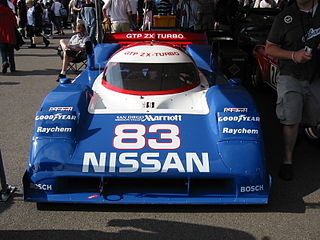
The Nissan Present the 39th Annual 12 Hours of Sebring International Grand Prix of Endurance, was the third round of both the 1991 Camel GT Championship and Exxon Supreme GT Series and was held at the Sebring International Raceway, on 16 March.

The March 86G was a Group C and IMSA GTP sports racing car built by March Engineering. Built as simply a chassis with no engine, it was branded as one of three cars, the BMW GTP, the Buick Hawk or the Nissan R86V depending on which engine was placed in the chassis and which team was running it. There were a number of subtle bodywork changes to reflect the manufacturer which ran the car.

















